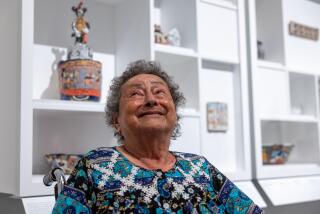Pieces of Mind : The Schlosses’ Love of Art Sculpted an Impressive Career
- Share via
Lillian Schloss’ career as an art collector began with a modest investment in 1952, when she and her husband, Ezekiel, drove from their apartment in New York City to Mexico as tourists.
The couple bought a small pot for $3.
“That was our budget,” recalled Schloss in a recent phone interview from New York. “At the time, pre-Columbian art was nothing.”
Upon their return to New York, the couple was offered $100 for that pot--and a career was born. After detouring into Greek and Roman art, the Schlosses focused on Chinese tomb sculpture.
Twelve years ago, with Ezekiel in failing health, the Schlosses sold off part of their tomb-sculpture collection at Sotheby’s: 50 pieces brought in almost $2 million.
Among the pieces sold was a Tang Dynasty horse that brought close to $700,000.
“We’d paid $8,000 in 1968,” said Lillian Schloss.
That piece is similar to one featured on the cover of the catalog for “Seeking Immortality,” a showing of 200 pieces from the Schloss collection of clay funerary art, known as mingqi (pronounced ming-chee), through March 16 at Bowers Museum of Cultural Art in Santa Ana. (Review, F1.)
“Art can be a very exciting commodity,” Schloss said. “But I don’t recommend this kind of dangerous living to everyone.”
She knows whereof she speaks: When Ezekiel died in 1987, the market for mingqi had changed dramatically. The Chinese government allowed a number of pieces to come onto the Western market--”including a lot of bad pieces,” Schloss said--and prices dropped.
Schloss kept buying.
“I don’t have any more money,” she said, “I blew it! The power of seeing a piece I just had to have was stronger than keeping the money [from the auction] in an investment.
“I hate to admit this, but I look forward to my little pension check every month,” said Schloss, who lives with her 12 cats in a seven-room apartment within walking distance of the Lincoln Center for the Performing Arts. Her cats are generally restricted to “the cat room,” she said, and the more fragile sculptures are kept under glass.
“I’m not a bag lady--the collection is worth a lot of money, [and] selling one piece would keep the bread on the table. But I don’t want to sell now. I’m very possessive of these pieces.”
The exhibition at the Bowers, which stretches from the Han to the Tang dynasties, includes some sculptures more than 2,000 years old. The exhibit will travel to two more venues before returning home to Schloss.
In fact, the show may get around more than the Schlosses ever did, unless you count the antique dealers and thrift shops of New York. Though tempted, the couple never visited Asia in pursuit of mingqi.
“When we were younger, we never had the money,” Schloss said. “It was always a question of money--and time too.”
As a high-school French teacher, Lillian Schloss had two months off each year. As a political cartoonist for the New York Times, New Republic and France-Amerique--and as art director and later editor of a magazine for Jewish children, World Over--Ezekiel Schloss rarely had the luxury of time off. The couple met through Ezekiel’s work at France-Amerique.
“It’s a very romantic story,” Lillian said. “We were very much in love. I’m 74; he’d be 84 now. I came from a Flemish-Catholic background. My husband was Jewish and came from the Baltic states, one step ahead of the Nazis.”
*
Chinese tomb sculpture would become Ezekiel’s greatest joy. According to Lillian, it would also be the death of him.
Ezekiel, who produced an exhaustive two-volume text on Chinese tomb sculpture, was considered the foremost expert on the subject. He curated his first, and last, exhibition of tomb sculpture for the opening in 1982 of the Temple of Heaven at Disney’s Epcot Center in Orlando, Fla.
“We were very flattered and well-paid,” Lillian recalled. “Unfortunately, my husband had heart problems, and the strain of doing this exhibition, the richness of the food, plus the tension and excitement--he had a major heart attack. He never got any better.”
Ezekiel underwent surgery, and Lillian retired from the city school system to take care of him until his death.
*
The objects Ezekiel collected, however, enjoy a degree of immortality virtually unheard of in other Chinese art forms. Little else, save some religious icons, survives from the Han Dynasty (206 BC to AD 220).
According to curator Janet Baker, the Bowers show represents the bulk of the Schloss collection. But, Schloss said, hundreds more items remain in her apartment. And apparently she’s found a way to stretch those pension checks.
“I bought a piece yesterday of a little Tang [Dynasty] lady,” she said. “The dress and outfit are so unique, three-color glaze. . . . But presently I’m in love with Tang polo players. Polo was the aristocracy’s big thing. Unfortunately, I bought these polo players after the exhibition was organized.”
More to Read
The biggest entertainment stories
Get our big stories about Hollywood, film, television, music, arts, culture and more right in your inbox as soon as they publish.
You may occasionally receive promotional content from the Los Angeles Times.










